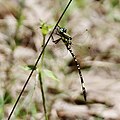| Royal tigertail | |
|---|---|
 | |
| Male, Cessnock NSW | |
| Scientific classification | |
| Kingdom: | Animalia |
| Phylum: | Arthropoda |
| Class: | Insecta |
| Order: | Odonata |
| Infraorder: | Anisoptera |
| Family: | Synthemistidae |
| Genus: | Parasynthemis Carle, 1995 [2] |
| Species: | P. regina |
| Binomial name | |
| Parasynthemis regina | |
 | |
| Synonyms [4] | |
| |
Parasynthemis regina is a species of dragonfly in the family Synthemistidae, [4] known as the royal tigertail. [5] It is a medium to large and slender dragonfly with a long body and black and yellow markings. [5] [6] It inhabits stagnant pools and swamps in eastern Australia [7]
Contents
Parasynthemis regina was originally named Synthemis regina in 1874 by Edmond de Sélys Longchamps. [8]



